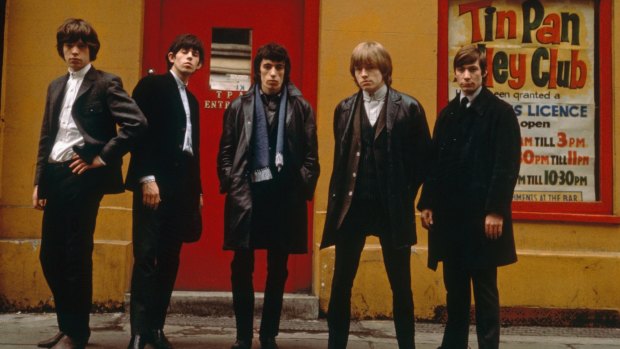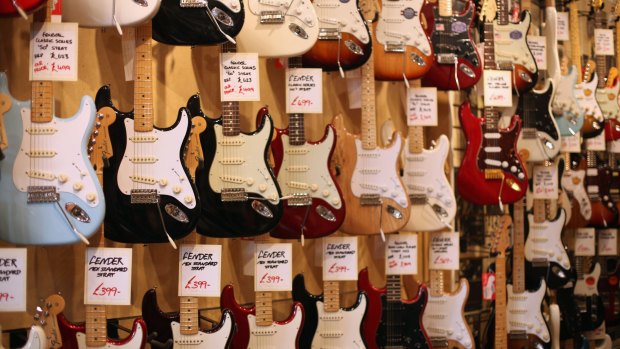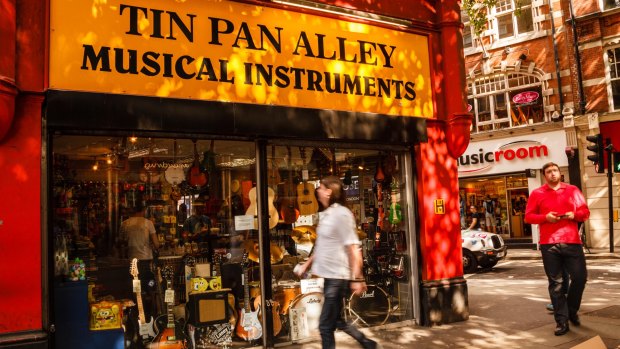By Paul Chai

The Rolling Stones outside the Tin Pan Alley Club in London, 1963. From left to right: Mick Jagger, Keith Richards, Bill Wyman, Brian Jones and Charlie Watts. Credit: Getty Images
There is a battle going on just metres from London's Tottenham Court Road tube station – and it is not between bargain hunters on nearby Oxford Street – this is a fight to preserve one of the most important streets in the city's storied musical history. Denmark Street – known to the faithful as Tin Pan Alley – was home to the music industry for more than 100 years. Important studios were located there: the Rolling Stones recorded their debut at Regent Sounds and Donovan recorded his eponymous debut at Southern Music's Studios. Denmark is also the only street full of musical instrument shops in Britain, if not the world.
But this historic strip of guitar shops, drum sellers and rehearsal studios is currently caught in a perfect construction storm with the building of a huge new hotel and the Crossrail project that aims to link Heathrow Airport, the West End, the City of London and Canary Wharf. The result is that the street has been surrounded by chaos and landmarks have been destroyed.
I first discovered this musical enclave in my 20s when a singer-songwriter friend would play at the intimate 12 Bar Club. This proving ground for artists such as Martha Wainwright, Adele and the Libertines used a 14th-century forge as its stage; the performers surrounded in an ancient brick hug, the audience crammed standing in front or sitting on the balcony that always felt as it if might topple over if the crowd got too enthusiastic. This didn't feel like playing someone's lounge room as much as squashing into a friend's hallway with a band and 50 of your new best friends. Between gigs patrons would go for air in the alley where you might find the band having a cigarette.

Guitars in a shop on Denmark Street.Credit: Getty Images
The 12 Bar Club is gone now, subsumed into the hotel complex, though the historic forge has been preserved thanks, in part, to a popular kick back against the destruction of London's music history.
The Save Tin Pan Alley movement was founded by Henry Scott-Irvine, who is also crowd-funding a documentary, Tin Pan Alley Tales, to preserve the area's unique history. Scott-Irvine wants the area to become a Music Heritage Zone with music-related businesses granted special exemptions to help keep them in what is becoming a very gentrified spot.
"Hotels, apartments and restaurants will be the order of the day if the Camden planners and councillors continually fail to see the long game of developer-loophole-chess being played out in the front of everyone's eyes," he says. "Only Tommy, 'the deaf, dumb and blind kid' from The Who's rock opera could fail to see this."

The music shops line Denmark Street.Credit: Alamy
I am back on Tin Pan Alley listening to the dissonant music of the heavy machinery to see how much damage has been done. Walking the guitar shops, stuffed so full of Fenders and Gibsons you fear they may burst, you can imagine a gangly Keith Richards lighting a cigarette as he leans against the distressed brick walls in a break between recordings. The shopfronts date back to the 17th century and music wafts out of the shops as customers test the merchandise, if you can hear it amid the din. The cobbled laneway where we used to spill out of the 12 Bar is gone, along with the club itself, roads are closed and the small street is towered over by new steel and concrete giving it the look of a film set – like a real life Diagon Alley from Harry Potter, secreted away from daily commuters; the shininess of the new buildings serves to highlight the pleasantly ramshackle nature of the street itself.
But Save Tin Pan Alley doesn't want the street preserved in formaldehyde they want it to continue to make a valuable contribution to the music scene that has given the world everything from the Stones and the Pistols to Royal Blood and London Grammar.
And that is something worth fighting for, so come on people, make some noise.
TRIP NOTES
MORE INFORMATION
GETTING THERE
British Airways flies from Sydney and Melbourne to London via Singapore, britishairways.com. Qantas operates daily flights to London Heathrow from Sydney and Melbourne via Dubai, qantas.com.
SEE AND DO
If you want to learn more about the Save Denmark Street movement see savetpa.tk.
Paul Chai travelled at his own expense.
Five more offbeat London music landmarks
THE 100 CLUB
One club to survive the Oxford Street area's drastic changes is the 100 Club which has been putting on live music since 1964 and has seen performances from the Who, the Kinks, the Stones – it would be easier to list the famous bands that haven't played this tiny space. 100 Oxford Street, Fitzrovia; the100club.co.uk
THE TURK'S HEAD
This pub is best known as a rugby hangout, where local tradition dictates that, if you have been to the game at nearby Twickenham Stadium, after a few pints friends lift you skyward like a rugby player and you stick your ticket to the roof of the pub. But this was also Ringo Starr's local watering hole, though you would barely know it save for a black-and-white Beatles photo in the men's toilet, and the occasional well-researched Beatles tourist braving the rugby scrums. 28 Winchester Road, Twickenham; turksheadtwickenham.co.uk
THE GHOST OF BOWIE
A nondescript laneway, just west of the far more famous Carnaby Street, is where David Bowie stood for the cover of The Rise and Fall of Ziggy Stardust. Not too much has changed, apart from the K.West sign that was above Bowie's head, squint and you can almost see him. 23 Heddon Street, Soho, London
URBAN OASIS
The bustling Berwick Street in Soho was the scene of a more recent classic album cover, What's the Story Morning Glory by Oasis. Liable to be full of bustling office types by day and enthusiastic drinkers by night you won't be able to reproduce the cover yourself, but you can say you've seen it. Berwick Street, Soho, London
JIMI HENDRIX'S HOUSE
Had Jimi Hendrix and composer George Frideric Handel lived at the same time they would have shared a common wall when they resided in London. Now there is a quirky museum at this address that seeks to promote both of these very different musical geniuses. 23-25 Brook Street, London; handelhendrix.org
Sign up for the Traveller Deals newsletter
Get exclusive travel deals delivered straight to your inbox. Sign up now.